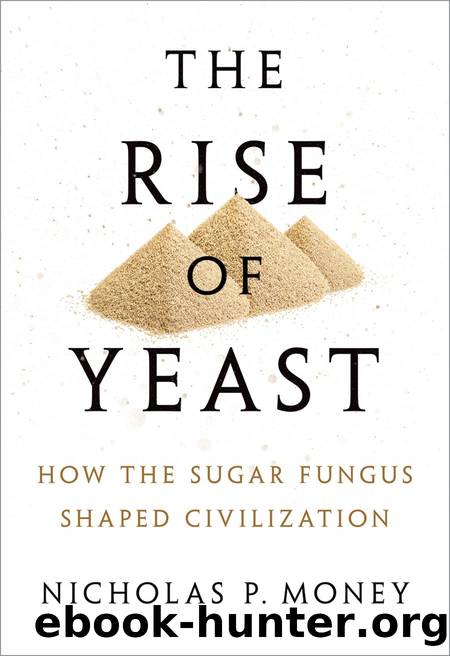The Rise of Yeast by Nicholas P. Money

Author:Nicholas P. Money [Money, Nicholas P.]
Language: eng
Format: epub
ISBN: 9780191066634
Publisher: Oxford University Press
Published: 2017-10-30T00:00:00+00:00
To assess the costs and benefits of corn bioethanol properly, we have to consider the energy used to cultivate corn. Corn is an expensive crop, with conventional fuels needed to power the machinery, liberal applications of fertilizers, herbicides to keep the weeds away, insecticides to kill the pests, and lots and lots of water. Potassium fertilizers are produced from minerals extracted from deep mines and nitrogen fertilizers are made by the Haber processâan intensive chemical method which is responsible for 1â2 percent of total global energy consumption. Insecticides and herbicides are petroleum products. Most of the corn grown in the Midwest is transgenic, expressing the gene from the bacterium Bacillus thuringiensis (Bt) that encodes the Bt toxin that destroys caterpillars of the European corn borer. Unfortunately, planting Bt corn does not eliminate the use of conventional pesticides sprayed on the crop.
Many of these chemicals are transported thousands of miles to be spread and sprayed on Midwestern farmland. Runoff from soils bubbles in shallow ditches around the fields and trickles into larger streams that unite to form tributaries that feed into the Ohio River. The Ohio joins the Mississippi in Cairo, Illinois. Farther south, the waste fertilizers from the farmland spread through the southern bayous, and plankton blooms exhaust the oxygen in the infamous dead zone of the Gulf of Mexico. A foreshadow of the threat to marine life is obvious on my bicycle rides in Indiana, where fat tangles of bright green algae clog the streams draining the cornfields. Only the oldest residents can remember a time when there were any fish in these waters.
Ethane produced from natural gas in Pennsylvania is piped beneath my bike route and it may be joined by a bioethanol pipeline before too long. Most bioethanol is transported by rail and truck today, because it causes corrosion cracking that damages pipelines. Ethanol is very flammable too, but the technology is advancing, and a 2,700-kilometer route for a bioethanol pipeline has been proposed. This would complete the conversion of the Midwest from rural farmland into a vast biorefinery.
Modern industrial farming is an exercise in rolling big boulders up hills without recouping enough energy as the boulders run downhill. The energy input is greater than the energy output. This is the second law of thermodynamics and nobody, not even the rain, can disobey the second law. Critics of biofuels seem to have won the scientific argument for now, but only if we do not consider the alternatives. Continuing to meet our energy needs with power plants that run on coal, oil, and natural gas is worse than using bioethanol, albeit marginally, in terms of greenhouse gases.5
A similarly massive energy input is need to grow sugarcane, but at least the resulting crop provides sucrose, rather than cornstarch, which yeast can ferment as soon as it is squeezed from the plant. Sugarcane has been cultivated in Brazil for 500 years and bioethanol production from the crop became a serious business during the oil crisis in the 1970s. Brazil is
Download
This site does not store any files on its server. We only index and link to content provided by other sites. Please contact the content providers to delete copyright contents if any and email us, we'll remove relevant links or contents immediately.
| Cell Biology | Developmental Biology |
| Entomology | Marine Biology |
| Microbiology | Molecular Biology |
| Biostatistics |
Sapiens: A Brief History of Humankind by Yuval Noah Harari(14244)
The Tidewater Tales by John Barth(12608)
Mastermind: How to Think Like Sherlock Holmes by Maria Konnikova(7222)
Do No Harm Stories of Life, Death and Brain Surgery by Henry Marsh(6887)
The Thirst by Nesbo Jo(6826)
Why We Sleep: Unlocking the Power of Sleep and Dreams by Matthew Walker(6618)
Life 3.0: Being Human in the Age of Artificial Intelligence by Tegmark Max(5474)
Sapiens by Yuval Noah Harari(5293)
The Longevity Diet by Valter Longo(5017)
The Body: A Guide for Occupants by Bill Bryson(4973)
The Rules Do Not Apply by Ariel Levy(4842)
The Immortal Life of Henrietta Lacks by Rebecca Skloot(4523)
Animal Frequency by Melissa Alvarez(4394)
Why We Sleep by Matthew Walker(4358)
The Hacking of the American Mind by Robert H. Lustig(4318)
Yoga Anatomy by Kaminoff Leslie(4303)
All Creatures Great and Small by James Herriot(4228)
Double Down (Diary of a Wimpy Kid Book 11) by Jeff Kinney(4204)
Barron's AP Biology by Goldberg M.S. Deborah T(4095)
